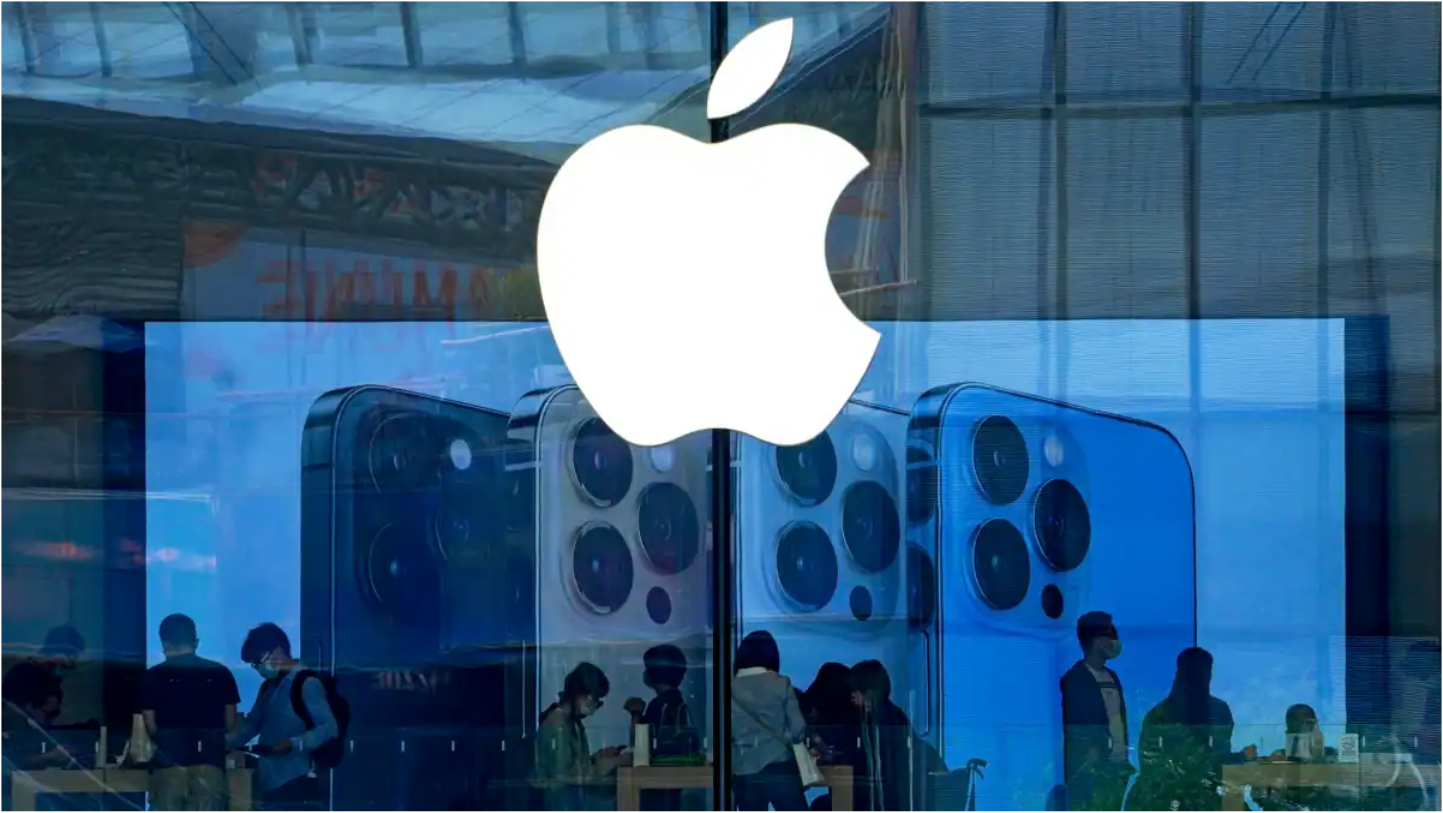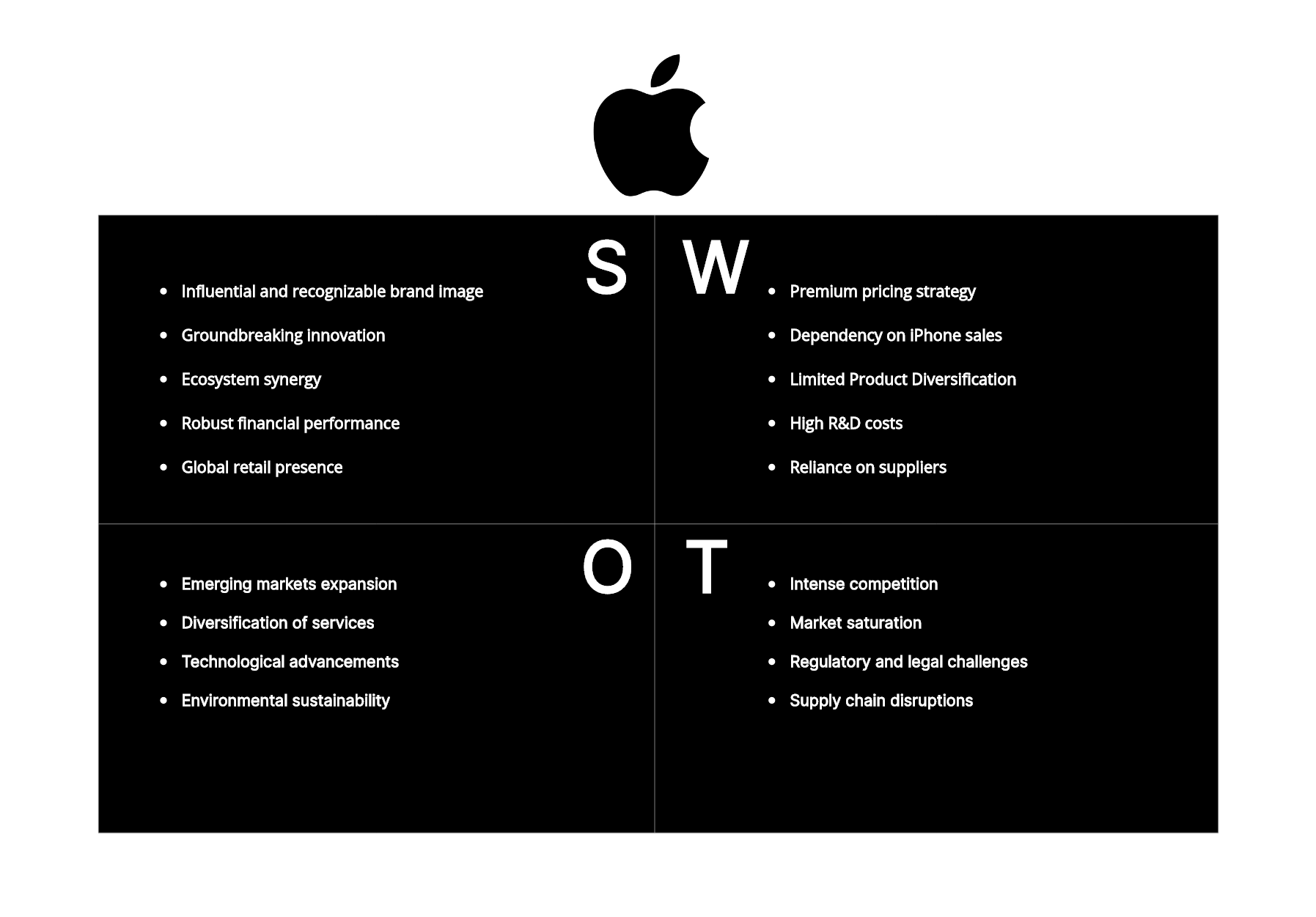Apple Inc. is a global technology juggernaut that has redefined the landscape of personal computing and communication. The company's unwavering commitment to innovation and design has propelled it to the forefront of the industry. Apple has amassed a dedicated following worldwide. In this Apple SWOT analysis, we examine the key factors influencing Apple's position in the market. Keep reading.

What Is the SWOT Analysis
The SWOT analysis is a strategic framework used to evaluate the internal and external factors that influence an organization's performance and position in the market. The acronym "SWOT" stands for Strengths, Weaknesses, Opportunities, and Threats, representing the four key elements assessed in this analysis.

Strengths: These are the internal attributes and capabilities that give an organization a competitive edge. They encompass areas where the organization excels, such as unique resources, expertise, or a strong brand image.
Weaknesses: These are internal factors that hinder an organization's ability to achieve its objectives. Weaknesses are areas that require improvement or pose challenges, potentially limiting the organization's effectiveness.
Opportunities: These are external factors in the business environment that can be leveraged to create advantages. Opportunities may arise from market trends, technological advancements, or changes in consumer behavior.
Threats: These are external factors that have the potential to negatively impact an organization. Threats could include competitive pressures, economic downturns, regulatory changes, or emerging technologies from competitors.
An Overview of Apple
Founded in 1976 by Steve Jobs, Steve Wozniak, and Ronald Wayne, Apple Inc. has become synonymous with innovation and design excellence. The company's pioneering journey began with the creation of the Apple I, and since then, it has consistently pushed the boundaries of technology. Notable milestones include the introduction of the Macintosh in 1984 and the game-changing iPhone in 2007. Apple's emphasis on sleek, user-friendly design has not only set industry standards but also garnered a dedicated global following. The seamless integration of hardware, software, and services across its product line has established the renowned "Apple ecosystem," offering users a cohesive and intuitive experience.

Today, Apple stands as a tech giant with a diverse product portfolio spanning iPhones, iPads, Macs, and an array of services like Apple Music and the App Store. The company's retail stores, known for their iconic architecture and exceptional customer service, have become cultural landmarks. With a relentless commitment to innovation, Apple continues to shape the future of technology and influence consumer lifestyles around the world.
Apple SWOT Analysis
Apple Inc. is a company that commands a prominent position in the global technology market. To understand its strategic standing, it's crucial to delve into the internal and external factors that shape its operations. Here, we conduct a comprehensive Apple SWOT analysis, examining the Strengths, Weaknesses, Opportunities, and Threats that influence Apple's market position.

Strengths of Apple
Apple's strengths lie at the core of its success story.
- Brand Power: Few companies boast a brand as influential and recognizable as Apple. Its brand power translates into unwavering customer loyalty, even amid intense competition.
- Innovation Leadership: Apple's reputation for groundbreaking innovation sets it apart. Products like the iPhone and MacBook have become benchmarks for quality and design in their respective categories.
- Ecosystem Synergy: The seamless integration between Apple's hardware, software, and services creates a cohesive user experience. This ecosystem encourages customer retention and cross-product adoption.
- Robust Financial Performance: Apple's financial stability and consistent revenue growth are a testament to its strong business model and strategic decision-making.
- Global Retail Presence: The company's retail stores serve as immersive brand experiences, offering expert assistance and community-building opportunities.
Weaknesses of Apple
Despite its immense success, Apple is not impervious to weaknesses. The weaknesses of Apple are as follows:
- Premium Pricing Strategy: Apple's products come with a premium price tag, limiting accessibility for a significant portion of potential customers. This could be a barrier to market share expansion.
- Dependency on iPhone Sales: The majority of Apple's revenue is generated from iPhone sales. While this has been a pillar of the company's success, it also exposes it to potential market fluctuations and changes in consumer preferences.
- Limited Product Diversification: While Apple has a diverse product line, a significant portion of its revenue comes from a handful of flagship products. This concentration may pose a risk in the face of evolving market demands.
- High R&D Costs: Maintaining a position at the forefront of innovation requires substantial research and development investment. While this fuels Apple's innovation engine, it also presents a financial challenge.
- Reliance on Suppliers: Apple's production relies on a network of suppliers, which can make it vulnerable to supply chain disruptions or issues with individual suppliers.
Opportunities of Apple
While Apple has achieved remarkable success, several opportunities can further bolster its position in the market.
- Emerging Markets Expansion: Venturing into untapped markets, especially in developing regions, presents a significant growth opportunity. Tailoring products and services to cater to diverse consumer needs can open up new revenue streams.
- Diversification of Services: Apple's services segment, including offerings like Apple Music, iCloud, and Apple TV+, has shown promise. Further diversification and expansion in the services sector can provide a stable revenue source alongside hardware sales.
- Technological Advancements: Staying at the forefront of emerging technologies like augmented reality (AR), artificial intelligence (AI), and machine learning (ML) can lead to the development of new, innovative products and services.
- Environmental Sustainability: With increasing consumer emphasis on sustainability, Apple's commitment to eco-friendly practices and renewable energy sources can be a significant market differentiator.
Threats of Apple
Despite its dominance, Apple faces several external threats that could potentially impact its operations.
- Intense Competition: The technology sector is highly competitive, with rivals constantly innovating and introducing new products. Maintaining a competitive edge requires continuous investment in research and development.
- Market Saturation: In mature markets, especially for smartphones, there's a risk of reaching market saturation. Sustaining growth in these areas may require a shift in strategy or tapping into new markets.
- Regulatory and Legal Challenges: Apple operates in a highly regulated industry, and legal challenges related to antitrust, intellectual property, and privacy concerns can pose significant risks.
- Supply Chain Disruptions: Global events, such as natural disasters or geopolitical tensions, can disrupt the supply chain, impacting production and distribution.
Key Takeaway: SWOT Analysis Template & Tool
In this comprehensive SWOT analysis, we've dissected Apple Inc.'s strategic landscape, uncovering key insights into its strengths, weaknesses, opportunities, and threats. This Apple SWOT analysis serves as a valuable blueprint for understanding the dynamics of a global tech giant, offering critical perspectives for informed decision-making.
For those inspired to embark on their strategic journey, Boardmix provides an invaluable resource. With a commitment to simplicity and effectiveness, Boardmix offers a suite of tools and templates designed to empower businesses and individuals in their strategic endeavors. Among them, the SWOT analysis template stands as a guiding light, offering a structured approach to evaluating internal and external factors, ultimately paving the way for a successful future.









